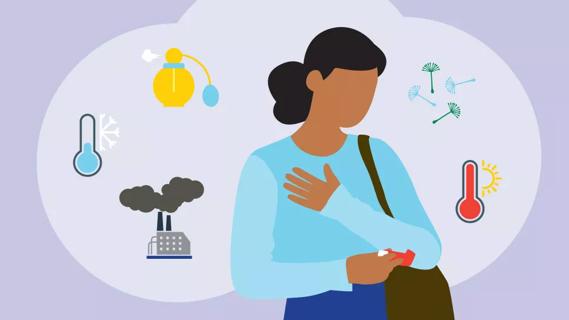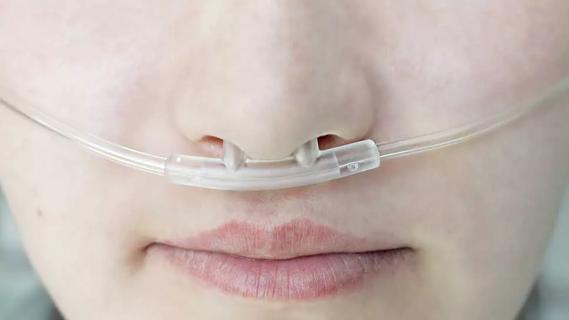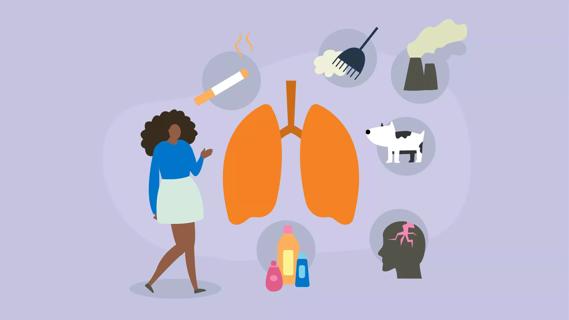Both conditions have similar symptoms, but different causes and treatments

Asthma and chronic obstructive pulmonary disease (COPD) both cause breathing problems. Both conditions are characterized by cough, shortness of breath and airflow limitation. But each requires a unique approach to care.
Advertisement
Cleveland Clinic is a non-profit academic medical center. Advertising on our site helps support our mission. We do not endorse non-Cleveland Clinic products or services. Policy
If you have trouble breathing, getting the right diagnosis is essential. Pulmonologist (lung specialist) Sobia Farooq, MD, explains the differences between asthma and COPD.
A healthcare provider can help you determine if you have asthma or COPD. “Sometimes, the difference is clear,” says Dr. Farooq. “People with COPD are typically over age 40 and have a history of smoking. For someone under age 40 who has never smoked, asthma is the more common diagnosis.”
But several factors can blur the line between asthma and COPD:
The main symptoms of asthma and COPD include:
Asthma symptoms typically appear as attacks (exacerbations), ranging from mild to severe. Between attacks, you may not have any breathing difficulties. Common triggers of asthma attacks include:
In COPD, you typically have symptoms all the time. But exacerbations can also occur. They often require hospitalization and may cause further lung damage, says Dr. Farooq. The most common triggers of COPD exacerbations are respiratory tract infections.
Advertisement
When two diseases are so alike, getting the right diagnosis requires careful attention to detail. According to Dr. Farooq, providers diagnose asthma and COPD based on:
Spirometry is the most readily available and useful lung function test. During the test, you take a deep breath in and a deep breath out. The test measures the volume of air exhaled at specific moments during your exhale. Your provider does a spirometry test to get a baseline measurement. Then, they can test how you respond to different medications:
Because asthma and COPD are so similar, providers may misdiagnose them. One study noted the importance of pulmonary function testing in making an accurate diagnosis. The researchers found that when providers didn’t use PFT, more than one-third of asthma and COPD diagnoses were incorrect.
Healthcare providers aren’t sure why some people develop asthma as children or adults. “It’s likely due to a combination of genetics and environmental exposures,” says Dr. Farooq. “People with a history of allergies and or family history of asthma have a higher asthma risk.”
The main cause of COPD is smoking, although you can have COPD even if you never smoked. Other possible causes include:
There are several common treatment strategies for asthma and COPD. Quitting smoking is one of the most important.
“Patients with COPD often ask if there’s a benefit to quitting smoking,” says Dr. Farooq. “The answer is ‘yes.’ When you quit smoking, your lungs’ natural defensive mechanisms come back, which can protect you from lung infections. Quitting smoking also slows down the decline in lung function and progression of COPD.”
Advertisement
It’s also important to avoid known triggers of asthma and COPD exacerbations and take steps to prevent respiratory tract illnesses.
Specific treatments for asthma and COPD include:
Asthma treatment usually includes one or more medications, depending on how severe your asthma is. Healthcare providers start with short-acting bronchodilators (rescue inhalers). If you’re still having symptoms, your provider may add in other medications, such as:
Avoiding triggers is also a very important part of managing asthma. Whether your triggers are environmental, pet dander, tobacco smoke, mold, pollution or others, it’s important to identify and avoid your triggers in order to manage your asthma.
Long-acting bronchodilators are the first-line treatment for COPD, often in combination with a short-acting bronchodilator. Your provider may also prescribe oral medications to help prevent COPD exacerbations.
Dr. Farooq recommends additional steps to help manage COPD:
Advertisement
You may have a higher chance of developing COPD if you have unmanaged, untreated asthma. “This is especially true if you didn’t receive proper asthma treatment over a substantial period of time, which can lead to changes in your airways,” explains Dr. Farooq.
It’s also possible to have both asthma and COPD, a condition called asthma-COPD overlap (ACO). If you have ACO, your treatment plan will include medications for both conditions.
Asthma and COPD can both be serious, and neither has a cure. But with your healthcare team’s guidance, you can manage these conditions. Follow your recommended treatment plan to help you avoid exacerbations and live a healthier life.
Advertisement
Learn more about our editorial process.
Advertisement

You can reduce your chances of a flare-up by quitting smoking, avoiding respiratory infections and following your doctor’s orders

Get improved quality of life and breathe better

Quitting smoking helps immediately, but this disease doesn’t only affect people who smoke

Often, a throat tickle is due to a cold, allergies or GERD — but see a doctor if it won’t go away

The effectiveness and safety of many of these options are unknown, so it’s best to stick to traditional care

Avoid triggers like dust, smoke and cold air to lessen your chances of coughing

Developmental changes like puberty and menopause can impact symptom severity

Type 2 diabetes isn’t inevitable with these dietary changes

Applying a hot or cold compress can help with pain